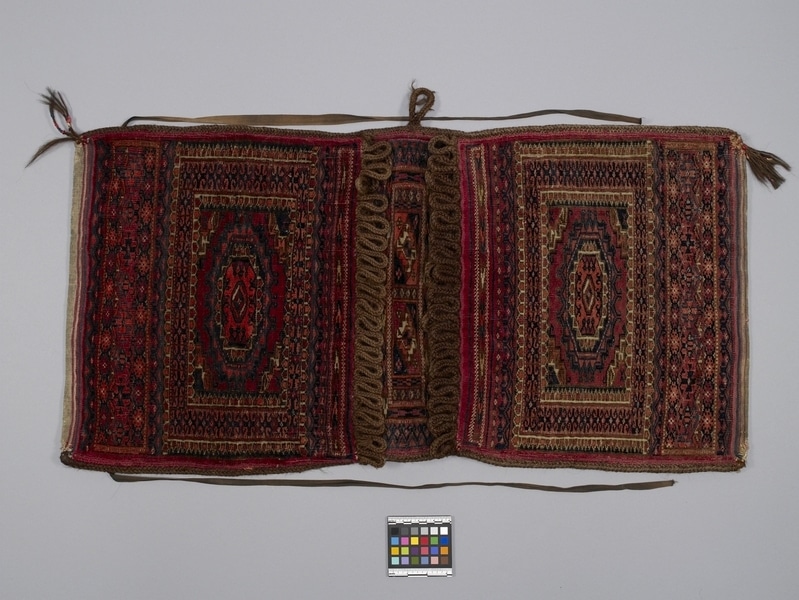Saddlebag Item Number: 1358/1 from the MOA: University of British Columbia


Description
A saddlebag constructed from a long continuous length of off-white striped wool canvas, which is folded and seamed onto itself at each end to form a pair of bags of equal size (panniers). The fronts of both bags, as well as the “bridge” that separates the two bags, are decorated with large rectangular panels of very finely knotted pile weaving that is worked on the canvas. The piece is tightly woven and quite stiff. The design motifs on the pile woven sections is consisting of octagonal and other geometric forms with shades of red, and brown predominating. The outside edges of the saddle bag are bound with braided brown goat or camel hair and the opening of each bag is finished with dense loops of braided goat or camel hair. There are colourful tassels at the corners and on the back of one bag, a length of brown cotton twill tape is attached.
History Of Use
Saddlebag used on a horse or camel for personal and/or commercial purposes.
Narrative
Collected in the early 1920’s by Leonard S. Klinck, then president of the University of British Columbia, in North Africa or Central Asia.
Item History
- Made in Afghanistan ? or Turkmenistan ? before 1925
- Owned by Leonard S. Klinck
- Owned by Vernon C. Brink before July 19, 1989
- Received from Vernon C. Brink (Donor) on July 19, 1989
What
- Name
- Saddlebag
- Identification Number
- 1358/1
- Type of Item
- saddlebag
- Material
- wool fibre, camel hair fibre ?, goat hair fibre ?, cotton fibre, silk fibre and dye
- Manufacturing Technique
- woven, knotted and braided
- Overall
- height 5.0 cm, width 89.7 cm, depth 46.2 cm
Who
- Culture
- Baluchi ?
- Previous Owner
- Leonard S. Klinck and Vernon C. Brink
- Received from
- Vernon C. Brink (Donor)
Where
- Holding Institution
- MOA: University of British Columbia
- Made in
- Afghanistan ? or Turkmenistan ?
When
- Creation Date
- before 1925
- Ownership Date
- before July 19, 1989
- Acquisition Date
- on July 19, 1989
Other
- Item Classes
- textiles
- Condition
- good
- Accession Number
- 1358/0001